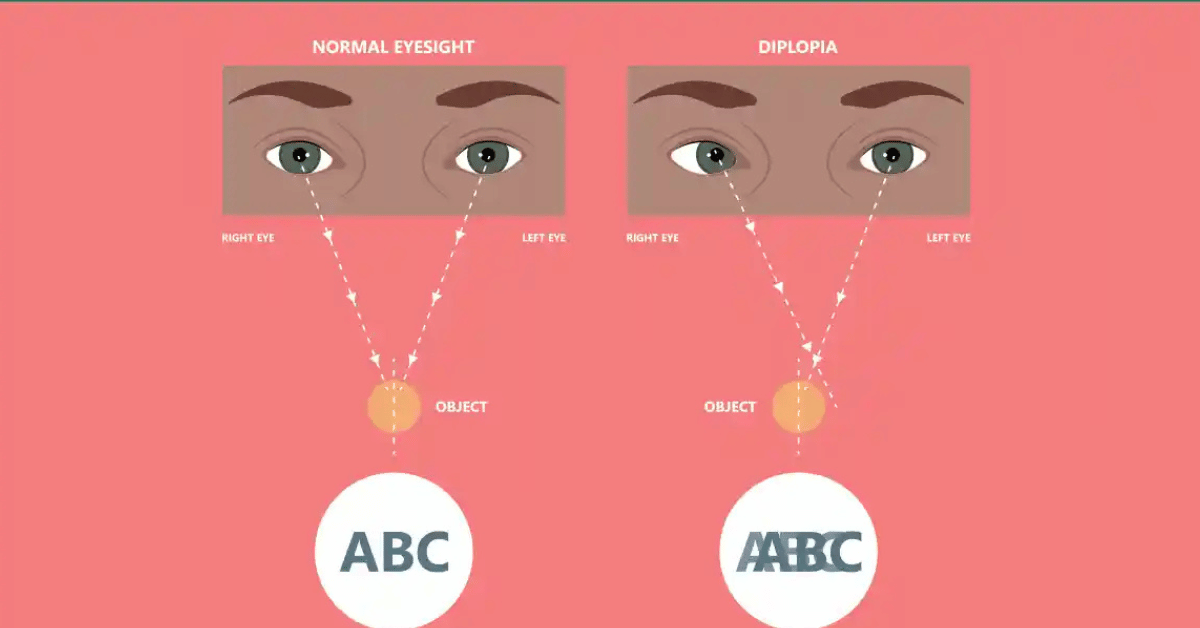Introduction
Diplopia, commonly known as double vision, is a condition that affects many individuals and can significantly impact daily life. Seeing two images of a single object can be confusing, distressing, and even dangerous if left untreated. Understanding the causes, symptoms, and available treatment options is essential for managing this condition effectively. If left unaddressed, conditions like Refractive Errors can contribute to visual disturbances, making it crucial to seek professional guidance. In this blog, we will explore everything you need to know about diplopia, including its root causes, key symptoms, and the best treatments available today.
What is Diplopia?

Diplopia is a vision disorder where a person perceives two images of a single object. These images may appear side by side, on top of each other, or a combination of both. Diplopia can be classified into two main types:
- Monocular Diplopia: The double vision persists even when one eye is closed, often caused by corneal irregularities, cataracts, or refractive errors.
- Binocular Diplopia: The double vision disappears when one eye is closed, typically caused by misalignment of the eyes due to neurological or muscular issues.
Understanding these types is crucial in determining the cause and selecting the appropriate treatment.
Causes and Symptoms of Diplopia
Common Causes of Diplopia
Several factors can lead to double vision, including:
- Refractive Errors: Conditions like astigmatism or cataracts can cause light to bend improperly, leading to double vision.
- Neurological Conditions: Stroke, brain tumors, or multiple sclerosis can affect the nerves controlling eye movement, leading to misalignment.
- Eye Muscle Disorders: Strabismus, a condition where the eyes do not align properly, can result in binocular diplopia.
- Trauma or Injury: Head injuries or damage to the eye muscles can cause vision misalignment.
- Diabetes: Diabetic neuropathy can damage the nerves that control eye movement, leading to double vision.
- Graves’ Disease: A thyroid condition that can cause swelling in the eye muscles, leading to misalignment and double vision.
Recognizing Symptoms of Diplopia
People with diplopia may experience:
- Seeing double images that may be side by side or overlapping
- Eye strain or discomfort
- Difficulty in focusing on objects
- Headaches or dizziness
- Trouble with depth perception
If you experience persistent double vision, it is crucial to seek medical advice for an accurate diagnosis and timely treatment.
Best Treatment Options for Diplopia
1. Corrective Lenses
For those with refractive errors, eyeglasses or contact lenses can help correct vision problems and eliminate double vision. Special prism glasses may also be prescribed to align images properly.
2. Eye Exercises and Therapy
In cases where eye muscle imbalance is the cause, vision therapy can help improve coordination. Exercises that strengthen eye muscles and enhance alignment can be beneficial, especially for individuals with mild strabismus.
3. Medications
For conditions like Graves’ disease or multiple sclerosis, medications may be prescribed to reduce inflammation and improve eye function. In cases of myasthenia gravis, which affects nerve signals to muscles, certain drugs can enhance neuromuscular transmission.
4. Surgery
For severe cases where double vision is caused by cataracts, nerve damage, or strabismus, surgery may be required. Eye muscle surgery can help align the eyes properly, while cataract surgery removes clouded lenses to restore clear vision.
5. Lifestyle Adjustments
For patients with diplopia due to underlying medical conditions such as diabetes, managing blood sugar levels, maintaining a healthy diet, and following prescribed treatments can help prevent complications that affect vision.
Meet Dr. Smita Mukherjee
Dr. Smita Mukherjee is a senior ophthalmologist with over 30 years of experience. After earning her post-graduation degree from Seth G.S. Medical College with academic honors, she joined the faculty of the same institution. During her tenure, she examined and treated a vast number of patients, gaining expertise in various branches of ophthalmology.
Dr. Mukherjee was a recognized university post-graduate teacher, training multiple batches of students. Since 1997, she has been practicing at well-equipped clinics in Mumbai, including Eye Solutions Clinic, Chembur.
Her areas of specialization include Cataract Surgery, Phacoemulsification, Refractive Errors, Diabetic Retinopathy, and Age-Related Macular Degeneration.
For consultations, visit: Eye Solutions Clinic 401, Pearl Belleza, D. K. Sandu Marg, 19th Road Corner, Chembur, Mumbai 400071
FAQs
1. Can diplopia go away on its own?
- In some cases, temporary diplopia caused by fatigue or minor eye strain may resolve on its own. However, persistent double vision requires medical evaluation.
2. How is diplopia diagnosed?
- An eye specialist will conduct a thorough examination, including vision tests, eye alignment assessments, and possibly imaging scans to determine the underlying cause.
3. Are there any home remedies for double vision?
- While resting your eyes and practicing eye exercises can help in some cases, professional diagnosis and treatment are essential for effective management.
4. Can diplopia be a sign of a serious condition?
- Yes, double vision can indicate neurological disorders, stroke, or diabetes-related complications. Immediate medical attention is advised if symptoms persist.
5. What lifestyle changes can help with diplopia?
- Managing blood sugar levels, reducing screen time, staying hydrated, and wearing prescribed corrective lenses can help prevent or manage double vision.
6. Is surgery the only option for treating diplopia?
- Not always. Many cases are managed with glasses, vision therapy, or medications. Surgery is considered when other treatments are ineffective.
Conclusion
Diplopia, or double vision, can be a distressing condition, but understanding its causes, symptoms, and treatment options can help individuals seek timely medical intervention. Whether caused by refractive errors, neurological issues, or eye muscle disorders, various treatment methods are available, ranging from corrective lenses to surgical procedures. If you or a loved one experiences double vision, consulting an experienced ophthalmologist like Dr. Smita Mukherjee can provide the right diagnosis and treatment plan. Prioritize your eye health, and don’t hesitate to seek professional care for clearer, more comfortable vision.
